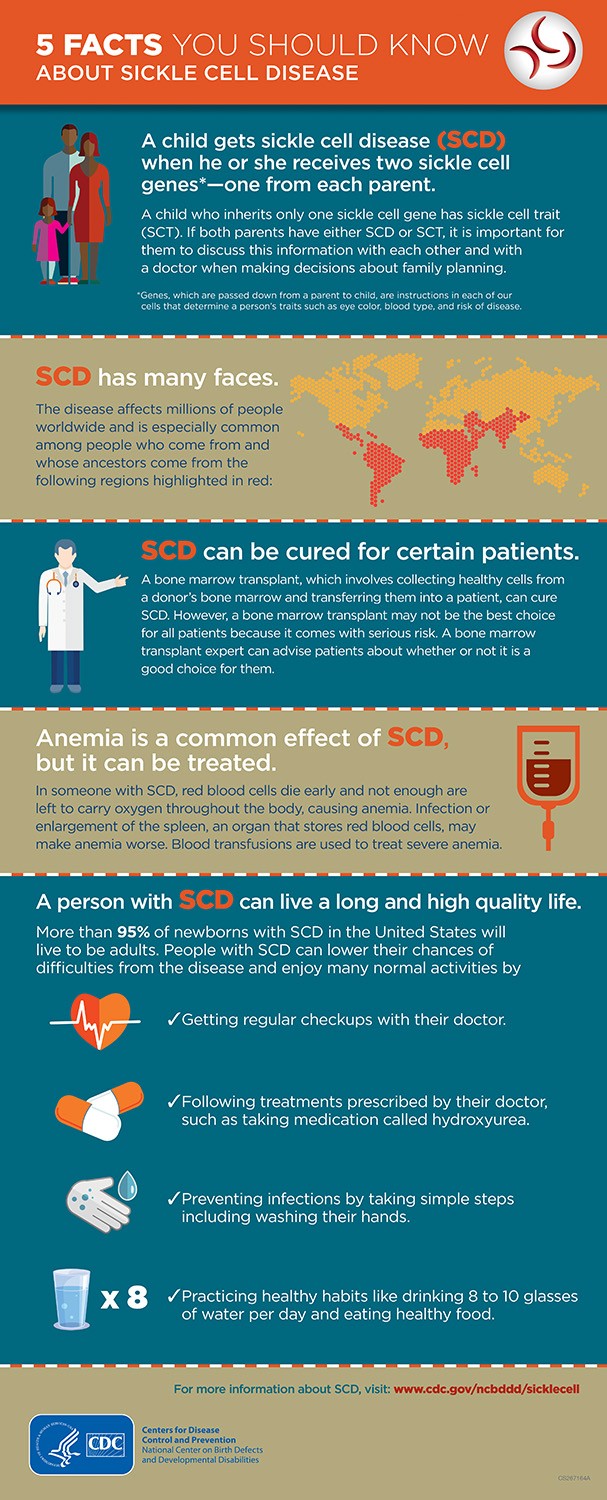National Sickle Cell Awareness Month

Story by Cheri Woodsmall
Sickle cell disease is an inherited blood disorder that affects red blood cells. People with sickle cell disease have red blood cells that contain mostly hemoglobin S, an abnormal type of hemoglobin. Sometimes these red blood cells become sickle-shaped (crescent shaped) and have difficulty passing through small blood vessels. When sickle-shaped cells block small blood vessels, less blood can reach that part of the body. Tissue that does not receive a normal blood flow eventually becomes damaged. This is what causes the complications of sickle cell disease. There is currently no universal cure for sickle cell disease.
Hemoglobin is the main substance of the red blood cell. It helps red blood cells carry oxygen from the air in our lungs to all parts of the body. Normal red blood cells contain hemoglobin A. Normal red blood cells that contain hemoglobin A are soft and round and can squeeze through tiny blood tubes (vessels). Normally, red blood cells live for about 120 days before new ones replace them.
People with sickle cell conditions make a different form of hemoglobin A called hemoglobin S (S stands for sickle). Red blood cells containing mostly hemoglobin S do not live as long as normal red blood cells, their span being only about 16 days while normal red blood cells live about 120 days. They also become stiff, distorted in shape and have difficulty passing through the body’s small blood vessels. When sickle-shaped cells block small blood vessels, less blood can reach that part of the body. Parts of the body that don’t receive a normal blood flow eventually become damaged. This is what causes the complications of sickle cell disease although some individuals may be eligible for a curative bone marrow transplant.

Inheritance
Sickle cell conditions are inherited from parents in much the same way as blood type, hair color and texture, eye color and other physical traits. The types of hemoglobin a person makes in the red blood cells depend upon what hemoglobin genes the person inherits from his or her parents. Like most genes, hemoglobin genes are inherited in two sets, one from each parent.
Types of Sickle Cell Disease
There are several types of sickle cell disease. The most common are:
- Hemoglobin SS Disease, Hemoglobin SC Disease
- Sickle Beta-Plus Thalassemia
- Sickle Beta-Zero Thalassemia
Most individuals with sickle cell disease have hemoglobin S, but some make a different type of abnormal hemoglobin like hemoglobin C, hemoglobin D, or hemoglobin E. Also, some individuals can have sickle cell disease because of co-inheritance of beta thalassemia. It is important to speak to your physician to understand what type you have.
The exact number of people living with SCD in the U.S. is unknown. Working with partners, the CDC supports projects to learn about the number of people living with SCD to better understand how the disease impacts their health.
It is estimated that:
- SCD affects approximately 100,000 Americans.
- SCD occurs among about 1 out of every 365 Black or African American births.
- SCD occurs among about 1 out of every 16,300 Hispanic-American births.
- About 1 in 13 Black or African American babies is born with sickle cell trait (SCT).

What Health Problems Does Sickle Cell Disease Cause?
“Pain Episode” or “Crisis”: Sickle cells don’t move easily through small blood vessels and can get stuck and clog blood flow. This causes pain that can start suddenly, be mild to severe, and last for any length of time.
Infection: People with SCD, especially infants and children, are more likely to experience harmful infections such as flu, meningitis, and hepatitis.
Hand-Foot Syndrome: Swelling in the hands and feet, often along with a fever, is caused by the sickle cells getting stuck in the blood vessels and blocking the blood from flowing freely through the hands and feet.
Eye Disease: SCD can affect the blood vessels in the eye and lead to long term damage.
Acute Chest Syndrome (ACS): Blockage of the flow of blood to the lungs can cause acute chest syndrome. ACS is like pneumonia; symptoms include chest pain, coughing, difficulty breathing, and fever. It can be life threatening and should be treated in a hospital.
Stroke: Sickle cells can clog blood flow to the brain and cause a stroke. A stroke can result in lifelong disabilities and learning problems.
Is There a Cure for Sickle Cell Disease?
To date, the only cure for SCD is a bone marrow or stem cell transplant.
- A bone marrow or stem cell transplant is a procedure that takes healthy stem cells from a donor and puts them into someone whose bone marrow is not working properly. These healthy stem cells cause the bone marrow to make new healthy cells.
- Bone marrow or stem cell transplants are very risky, and can have serious side effects, including death. For the transplant to work, the bone marrow must be a close match.
How You Can Help Bring Awareness
- Visit MySleevesUp.com, a website created by REdHHoTT (Registry and Education for Hemovigilance in Hemoglobinopathy Transfusion Therapy), to find educational resources and tools about blood donation and transfusions in SCD and learn how you can help spread the word about blood donation in your community.
- Share stories/awareness tips via Facebook, Instagram, and LinkedIn and use the following hashtags: #sicklecell #SickleCell Disease #SickleCellAwarenessMonth #ConquerSCD
Sources: sicklecelldisease.org, cdc.gov






